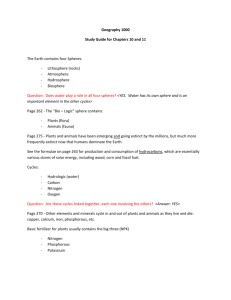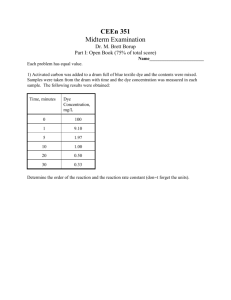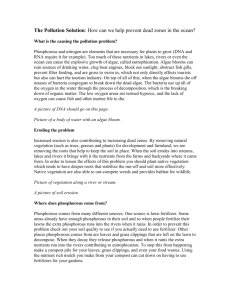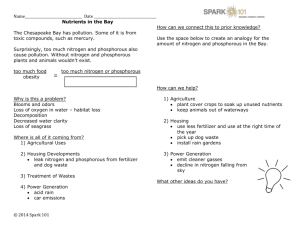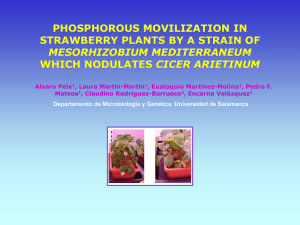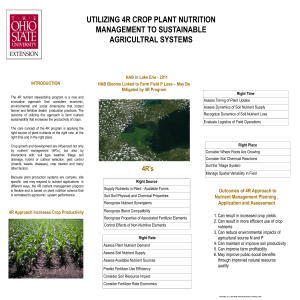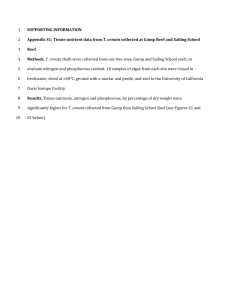Growing Green Waters
advertisement
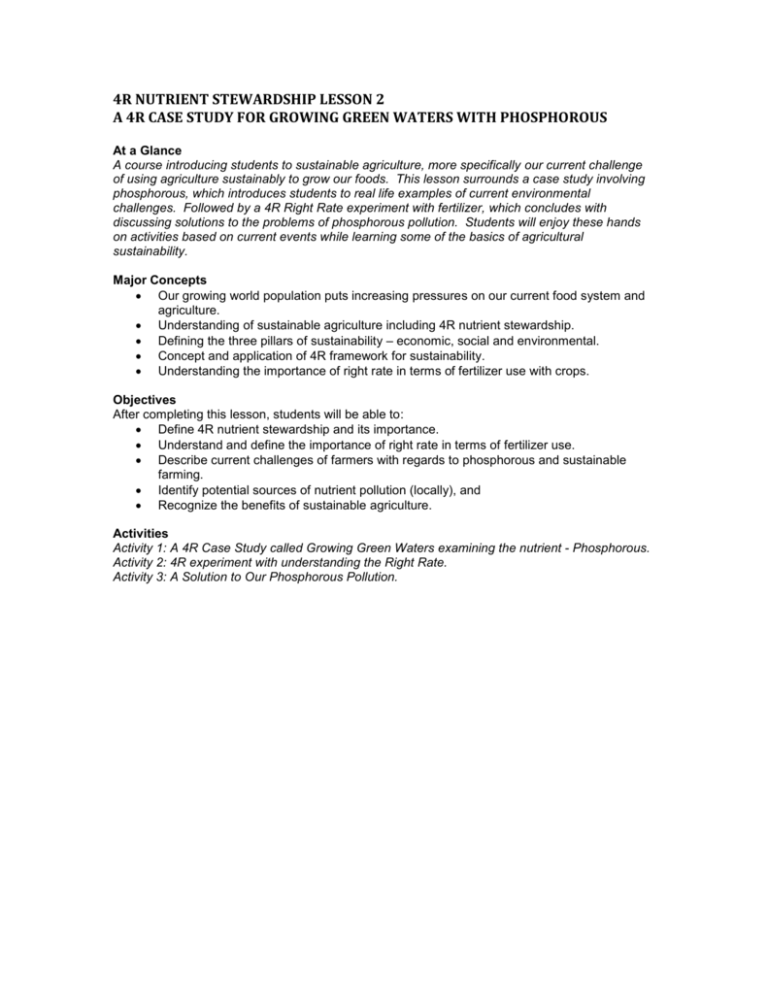
4R NUTRIENT STEWARDSHIP LESSON 2 A 4R CASE STUDY FOR GROWING GREEN WATERS WITH PHOSPHOROUS At a Glance A course introducing students to sustainable agriculture, more specifically our current challenge of using agriculture sustainably to grow our foods. This lesson surrounds a case study involving phosphorous, which introduces students to real life examples of current environmental challenges. Followed by a 4R Right Rate experiment with fertilizer, which concludes with discussing solutions to the problems of phosphorous pollution. Students will enjoy these hands on activities based on current events while learning some of the basics of agricultural sustainability. Major Concepts Our growing world population puts increasing pressures on our current food system and agriculture. Understanding of sustainable agriculture including 4R nutrient stewardship. Defining the three pillars of sustainability – economic, social and environmental. Concept and application of 4R framework for sustainability. Understanding the importance of right rate in terms of fertilizer use with crops. Objectives After completing this lesson, students will be able to: Define 4R nutrient stewardship and its importance. Understand and define the importance of right rate in terms of fertilizer use. Describe current challenges of farmers with regards to phosphorous and sustainable farming. Identify potential sources of nutrient pollution (locally), and Recognize the benefits of sustainable agriculture. Activities Activity 1: A 4R Case Study called Growing Green Waters examining the nutrient - Phosphorous. Activity 2: 4R experiment with understanding the Right Rate. Activity 3: A Solution to Our Phosphorous Pollution. Activity 1 Growing Green Waters Teacher Resource (TA) - A 4R Case Study Examining Phosphorous 4R Lesson 2 Activity 1 – A Case Study Challenge Examining Phosphorous Overview Activity one introduces students to real life examples demonstrating potential impacts of excessive fertilizer use and agricultural runoff, specifically using the nutrient phosphorous. This exercise will allow students to understand the potential impacts of excessive fertilizer use and its relevance on local drinking water systems and local watercourses. Students can complete this activity individually or in small groups, followed by students sharing results with the class. Materials Background Teacher Resource Material – Phosphorous Photocopied News Articles 1. Lake Simcoe 2. Lake Erie 3. Lake Winnipeg 4. Toledo Teacher PowerPoint Presentation *Please note all materials are available on our Nutrients For Life webpage accessed at: https://www.nutrientsforlife.ca/for-teachers/resources-by-topic/ PRE-ACTIVITY DISCUSSION Is Phosphorous a friend or foe? Introduce/review to students to the basics of the nutrient phosphorous and its many forms. It’s historical use, our current challenge and the concept of 4R Nutrient Stewardship. Please use our Teacher Resource information and corresponding PowerPoint Presentation available online for this 4R Nutrient Stewardship Case Study. Is Too Much Phosphorous – Too Much Of A Good Thing? Ask your class what happens if we use too much fertilizer (specifically phosphorous) on our crops? Can too much be too much of a good thing? What do you think might happen? INTRODUCE THE KEY CONCEPT: PHOSPHOROUS One of the environmental impacts of too much phosphorous is agricultural runoff into our local waterways and streams, and its byproduct is excessive algae, algal blooms, and sometimes even toxic blue-green algae. Agricultural runoff happens typically during excessive rainfall events, or during spring snowmelt events or sometimes if farmers apply too much fertilizer for the crop to uptake. Part of the challenge of being a farmer, or an agronomist is to understand how much is required for optimal crop growth. Remember as a farmer, farming is your business and you need to account for the cost of fertilizer (your input) and try to earn top dollars for your crops (your output). There used to be an old expression – “bigger inputs = bigger outputs.” Your challenge is to also think about your social, environmental, and economic impacts and goals relating to fertilizer use. Can you name some social, environmental, or economic goals of farming? Maybe ask yourself can farming be a sustainable practice? 2 Activity 1 Growing Green Waters Teacher Resource (TA) - A 4R Case Study Examining Phosphorous Case Study Challenge – Are We Growing Green Waters? Review with students the phosphorous cycle, the historical use of phosphorous, and the result of applying too much fertilizer. Can anyone give examples of current challenges as a result of agricultural runoff? What is happening in your areas? Activity Instructions 1. Ask students to form small groups (6-8 people). 2. Give each group a case study example of a news article (Lake Erie, Lake Simcoe (Ontario), Lake Winnipeg, Toledo). 3. Read and discuss each article within your group. 4. Ask how can we achieve environmental sustainability with agriculture and fertilizer? Let’s explore… 5. Our challenge is to feed more people with more food, using with less land and water resources. Lets review some of our current challenges. 6. Complete the following activity sheet for each article and be prepared to share your learning’s with your class. Each group will introduce and report on the current challenge, concerns, and outcome. 7. Discuss in your class what could be some possible solutions. 8. Introduce the concept of 4R nutrient stewardship to the class. 3 Activity 1 Growing Green Waters Teacher Resource (TA) - Farming 4R Manitoba Activity 1 Teacher Resource - Background Teaching Material on Phosphorous Lets Meet Phosphorous Phosphorous, also known as the element P on the periodic table, Atomic number 15, is one of the main essential ingredients in fertilizer. It has been also called the “devil’s element” not only because it was it the 13th element to be discovered, but it has had a colourful history in war and is also highly toxic when ingested. It is essential for optimal crop growth in agriculture, but in terms of water quality it has been related to a number of ecological and human health concerns when in excess. So we can question what makes it a friend or foe? From the element phosphorous comes phosphates, phosphates are the most common form of phosphorous on earth and consist of phosphorous bonded to atoms of oxygen. The Phosphorous Cycle and Runoff Potentials Phosphorous as an element naturally enters the environment from rocks or deposits from present from many years ago. The commercial form is known as apatite, and weathering and soil erosion gradually release natural amounts of phosphorous into our environment. Phosphorous is also water-soluble meaning it moves with the water. Human activities influence the phosphorous cycle and input other sources into the system. These come from mainly the synthetic sources of fertilizers. Municipal sewage treatment plants are also a source of added phosphorous to our waterways, along with the degradation of our wetlands – thereby eliminating our natural water’s filters in the environment. Animal wastes and manures also applied as fertilizers can be problematic if too much as applied or applied during winter months on frozen grounds. Feedlots are another example of potential agricultural runoff sources of fertilizer. Historical Use of Phosphorous During the 1960s, laundry detergents averaged roughly 10 per cent phosphorus by weight. Many waterways suffered from large algae blooms each summer. Some fish virtually disappeared from our waters. Research at Canada's famed Experimental Lakes Area -- now abandoned by the federal government - clearly documented the role of phosphorus. The Canada Water Act was amended in 1970 to require detergent manufacturers to reduce phosphate in detergents to 2.2 per cent by 1971. This was a key victory of the early days of the environmental movement. Since then, many waters have demonstrated considerable improvements in terms of phosphorous, until about five years ago when scientists began warning about excessive amounts of phosphorous showing up in our waters – Eutrophication it is called. But with the phosphates out of our detergents – what was the source of all this algae? Phosphorous and Fertilizer Phosphorous is essential for optimal plant growth and is a key ingredient used in fertilizers. Too much fertilizer for the plant can result in agricultural runoff and it’s a trend that seems to be increasing. Current Challenge with Phosphorous Excess phosphorous has been showing up in our waterways in Canada for a number years. Popping up everywhere from Lake Winnipeg, to Lake Erie, Lake Simcoe, and 4 Activity 1 Growing Green Waters Teacher Resource (TA) - Farming 4R Manitoba Lake Ontario in the summer months and then disappearing again. Is green water making a comeback and is it healthy? Our current challenge with phosphorous includes two main concerns. As we continue to put additional pressures on today’s farmers, agronomists, and scientists to keep farming competitive, combined with the needs of our growing populations and their need for more food, combined with our limited amount of farmland, and limited amount of freshwater sources – this creates a great challenge for everyone. Can we farm sustainably now and for the future? And what are the solutions to our growing green water problem? A Solution to Our Current Phosphorous Challenge One key solution to our current phosphorous challenge is 4R Nutrient Stewardship. According to the United Nations, the global population will increase by more than two billion people in the next 40 years, and many reports have indicated that agricultural production needs to double by 2050. Industry experts agree that increased production of food, fiber and fuel will be achieved by intensified production and not by expanded arable land base. Genetic and biotech seed industries have predicted yield increases of three to four percent per year. However, to optimize the yields of advanced seeds, fertilizer inputs must be optimized to provide the greatest potential for success. 4R provides a framework to achieve cropping system goals, such as increased production, increased farmer profitability, enhanced environmental protection and improved sustainability. To achieve those goals, the 4R concept incorporates the Right Source @ the Right Time, Right Rate, and Right Place. Properly managed fertilizers support cropping systems that provide economic, social and environmental benefits. On the other hand, poorly managed nutrient applications can decrease profitability and increase nutrient losses, potentially degrading water and air. 4R Nutrient Stewardship requires the implementation of best management practices (BMPs) that optimize the efficiency of fertilizer use. The goal of fertilizer BMPs is to match nutrient supply with crop requirements and to minimize nutrient losses from fields. Selection of BMPs varies by location, and those chosen for a given farm are dependent on local soil and climatic conditions, crop, management conditions and other site specific factors. 5 Activity 2 4R Experiment 4 Right Rate Teacher Resource – Teacher Instructions A 4R Experiment to Understanding the Right Rate Applications Overview In this part of the lesson, students in small groups will experiment by applying different rates of fertilizer to their plants. This hand’s on experiment will teach students the importance of understanding the right rate – one of the 4Rs of Nutrient Stewardship. Students will be asked to observe and record findings of their plants over a number of weeks. Materials Small pots/containers for growing plants (i.e three per each group - recycling bins, or large bins are ideal) 3 plants per group to represent a crop – suggested plants (corn, alfalfa, sunflowers, tomatoes, basil, or even Canadian grasses like wheat). Choose the same plant for each group and ideally a hardy, fast growing one. Extra soil Water Small amounts of a household all purpose fertilizer (i.e. miracle grow 24-8-16) Label for containers Source of light (light or a window) Ruler Paper and pencil/pen for recording Activity sheet for recording Small groups of students Next review with students the three essential and most common sources of nutrients N:P:K (Nitrogen, Phosphorous, and Potassium or Potash) needed for effective crop development. Split the students into small groups and ask them to think and brainstorm ideas about what would happen if you over applied or under applied fertilizer to plants? Next introduce the experiment to students and ask them to write a hypothesis (1 per group). Give each group needed materials and ask them to complete the experiment. Each week ask students to record results and discuss final outcomes. Complete the experiment with students. Ask students to graph and share their results of the experiment for each plant. Discuss with students the following questions: 1. 2. 3. 4. 5. What was the final outcome of your crop? Was your experiment fully successful? Under what conditions (what rate of fertilizer) did your crops grow best? What were the challenges What was the purpose of this experiment and how is it applicable to our local environment? 6 Activity 2 4R Experiment using Right Rate Student Resource (SR) - Student Instructions A 4R Experiment to Understanding the Right Rate Applications Student Activity Instructions 1. In your small group, re-read the experiments instructions. 2. Think about what might happen to each plant (crop). 3. Write a hypothesis in your group for this experiment. 4. Setup the experiment as per the Right Rate Experiment Instructions. 5. Complete experiment. 6. Observe and record results each week. 7. Finalize with your group your final results and share to class your experiment findings. My hypothesis is . . . . Right Rate Experiment Instructions 1. Label each container with the correct label [Control (1), Full (2), Double (3)]. 2. Transplant each crop into one of your three containers. 3. Measure and record each crop prior to any watering (height, width of leaves, length of leaves, # of flowers, etc.). 4. Your crop in container #1 will represent the control for the experiment – therefore only give it water and record each week, we will refer to the control as #1. 5. Container #2 represents your crop using the right rate application. Therefore water according to right rate instructions based on your all purpose fertilizer. Generally speaking fertilize once every 7 days and water also accordingly when plants seem dry. 6. Don’t forget to measure and record all amounts of water given to each plant. 7. Container #3 represents double the amount of fertilizer, therefore double the amount of fertilizer suggested by the instructions. Apply fertilizer once every 7 days but double the amount (rate) of fertilizer given to your crops. 8. Place your crops in a sunny window and watch your crops grow for six weeks. 9. Observe and record weekly your results in a table form, see the suggested table form (Table 1-1). 7 Activity 2 4R Experiment using Right Rate Student Resource (SR) - Student Instructions Table 1-1: Suggested table form for Right Rate Experiment. Week # Crop # Initial 1 Crop Height (cm) # of Leaves Length/Width of leaves (cm) # flowers State of crop (healthy, dead, alive, etc.) Amount of water/ Fertilizer (mL) 2 3 1. 1 2 3 2. 1 2 3 3. 1 2 3 4. 1 2 3 5. 1 2 3 6. 1 2 3 Final Avg. 1 2 3 10. Graph your results and review your crops results with your group. Share your results with the class. 11. Review and discuss the final outcomes of the experiment and the impact of using the Right Rate of fertilizer. Think about how this experiment may be applicable in real life. Discuss the importance of including a control in the experiment 8 Lesson Resource News Article 3, Activity 1 Toledo (Lake Erie) Activity 3 - Solutions to Growing Green Water Ask your students – What is the solution to our current challenges? Can we farm sustainably? What are the three pillars of sustainability? Overview In this third and final part of the lesson it’s time to talk about solutions to the potential pollution. Introduce and ask your students what is being done to minimize these environmental concerns related to agricultural runoff and fertilizer use? Discuss what actions might help? Review and discuss the results of Activities 1 and/or 2, then play a short video (4:38) about Farming 4R Manitoba featuring farmer Curtis McRae. Students will complete accompanied question sheet and further discuss solutions to our current challenge. Materials Video student answer sheet Video and audio equipment And popcorn (optional). Video: Farming 4R Manitoba, featuring Curtis McCrae. Farmer Curits McRae shows us his farm in Manitoba, and how he is using the 4R (the Right Source @ Right Rate, Right Time, Right Place® approach to Nutrient Management) on his farm to provide understanding of how various crop nutrients behave in the landscape, how they are used by crops and how to prevent their loss into the environment. The Province of Manitoba, Canada Fertilizers and Keystone Agricultural Producers (KAP) signed a 4R Nutrient Stewardship memorandum of understanding (MOU) that formalizes a joint commitment to support agriculture production and environmental protection through improved fertilizer use. Manitoba is the first prairie province to complete an arrangement with Canada Fertilizers on nutrient management and adoption/impact measurement. More information available at farming4Rfuture.ca Video: Farming 4R Manitoba: Featuring Curtis McCrae (4:38). Source: https://www.youtube.com/watch?v=6xISrwwXEA8 Instructions Watch the video and ask students to complete the questions associated with activity three and their student answer sheet. Closing Activity Summarize about the environmental concerns of excess phosphorous and agricultural runoff and the importance of using the right rate – one of the 4Rs of Nutrient Stewardship. Discuss with students what is happening in your areas, locally, regionally, provincially to protect local drinking water sources? Ask your class as a group - what they could do to help. “Never doubt that a small group of thoughtful, committed citizens can change the world; indeed, it's the only thing that ever has.” – Margaret Mead 9
